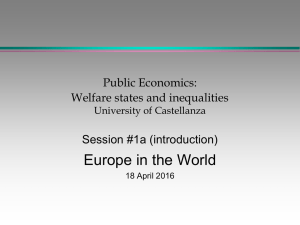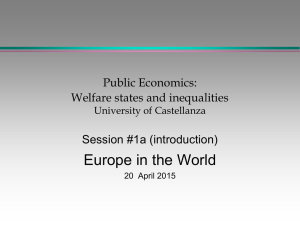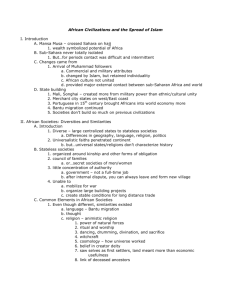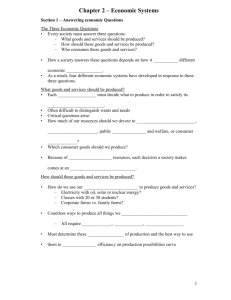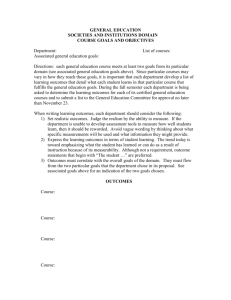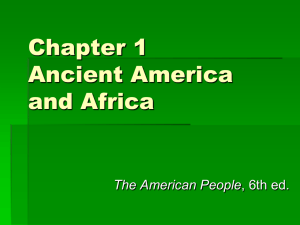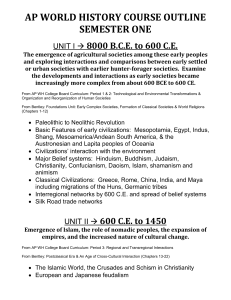Europe and USA
advertisement
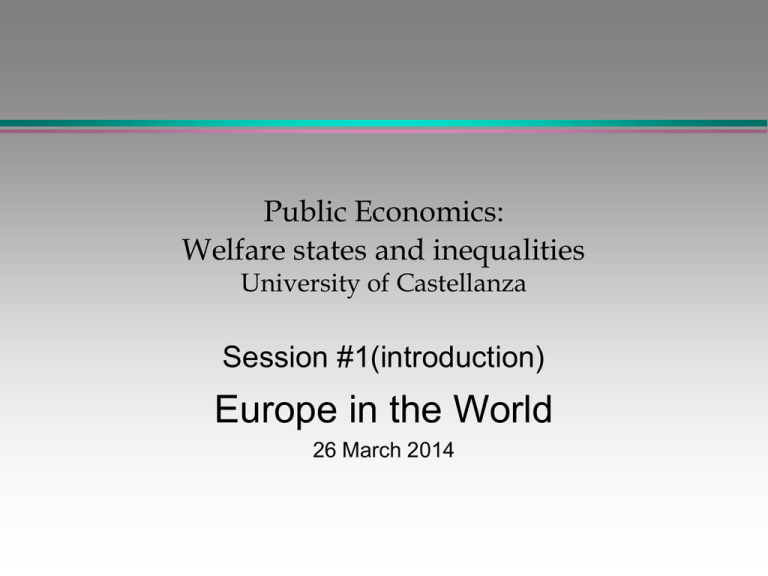
Public Economics: Welfare states and inequalities University of Castellanza Session #1(introduction) Europe in the World 26 March 2014 Three sessions The European Social Model (ESM) » Europe in the world » The European Social Model » Employment in Europe » Varieties of welfare state Blocked Societies Europe 2020 » Income inequality » Poverty, social inclusion and/or growth? Learning Objectives By Friday lunch-time you should be able to… Identify key differences between the social structure of Europe and the USA Identify the different forms of labour market participation and non-participation Differentiate between the main groups of European societies and welfare states Explain different employment rates across Europe Understand the concepts of income distribution and poverty Evaluate possible relationships between economic growth and European social policy Reading for today Anthony Giddens, Europe in the Global Age, Cambridge: Polity Press,2007, Chapter 1. James Wickham, ‘Potential and weaknesses of the European Social Model’, Employment Research Centre, Trinity College Dublin. Briefing paper for Infowork Project. Available at http://www.tcd.ie/ERC/symposiainfowork.php T.R. Reid, ‘The European Social Model’, Chapter 6 of The United States of Europe (2004). This first lecture What is distinctive about Europe? The EU and nation states Boundaries of Europe: Russia, Islam? Wealth Population War and peace Multiple boundaries Europe invented the nation state – the lines on the map are meant to mark out different national ‘societies’ But where does ‘Europe’ end? The Mediaeval European world » Overlapping jurisdictions (Church, feudal lord, monarch) » Institutions claiming ‘imperial’ authority – Papacy, Holy Roman Emperor » So rulers do not have absolute authority within their territory; boundaries are porous » In global terms very unusual – a political system rather than a single polity The Westphalian European world » 1648 Treaty of Westphalia – Ends Thirty Years War in Europe fought partly over religion » States are autonomous – Effectively recognise no external authority (e.g. Holy Roman Emperor) » Monarch is sole internal authority (cuius religio principle) – State has the monopoly of legitimate force (Weber) State-nations and nation-states States create nations » Peasants into Frenchmen (E. Weber) » Tax, military conscription, elementary schooling » ‘We have made Italy, now we have to make Italians’ (Garibaldi) National histories » ‘Nos ancêtres, les Gaulois’ » Construct the story of ‘we’ the nation National societies » National societies with national civil organisations (the Irish Labour Party, the Sociological Association of Ireland...). The border between states is a border between societies A post-Westphalian Europe Overlapping jurisdictions » Regional, national, European without complete hierarchy » ‘Multi-level governance’ Recognition of external authorities » EU (European Court of Justice) » ECHR European Court of Human Rights Multiple boundaries » Different organisations have different boudnaries Inter-governmental organisations » ECMT, ESA, EBU (Eurovision!), etc Boundaries (1) Russia Iron Curtain » Russian occupation of Hungary, Poland etc. from 1946 creates ‘Eastern Europe’ of satellite states » 1989 Fall of Iron Curtain: ‘Eastern Europe’ becomes Mitteleuropa - East ‘comes home’ Components of the lost Russian ‘ empire’ » Baltic states » Ukraine Really European? » Europe ‘from the Atlantic to the Urals’ (de Gaullle) » Our ‘common European home’ ‘We are Europeans’ (Mikhail Gorbachev, 1987) Self-definition » Both Russian and Turkish intellectuals often debate whether their country is ‘really’ European Boundaries (2) Islam 732 Battle of Poitiers » Islam ‘hides’ Europe from more advanced societies to the East (Pirenne) The emergence of Europe in the Middle Ages » Byzantine empire shields Europe from Islam : ‘Without Byzantium, Europe as we know it is inconceivable’. (Herrin, 2008:87) » ‘Reconquista’ of Iberian peninsula by end 15c. 1453 Fall of Constantinople » Turkish conquest of Balkans 1572 Battle of Lepanto » Then both Turkey and Spain turn away from the Mediterranean Emergence of Austria-Hungary » 1683 Turkish siege of Vienna lifted » 1686 ‘Liberation’ of Budapest » ‘European’ expansion into Balkans reaching Bosnia (1878) 2005 Turkey-EU negotiations begin Europe, the Balkans and Islam 732 Battle of Poitiers » Islam ‘hides’ mediaeval Europe from more advanced societies to the East » ‘Reconquista’ of Iberian peninsula 1453 Fall of Constantinople » Turkish conquest of Balkans 1572 Battle of Lepanto » Turning away from the Mediterranean Emergence of Austria-Hungary » 1683 Turkish siege of Vienna lifted » 1686 ‘Liberation’ of Budapest Expansion into Balkans from Ljubljana »2005 Turkey-EU negotiations begin....to Sarajevo Europe and the world population 1650-2000 7,000 6,071 6,000 5,000 4,000 27.3% 21.9% 3,000 World Europe Europe as % of total (right axis) 2,521 2,000 1,650 1,000 0 12.0% 1,262 556 112 791 127 163 978 203 276 408 547 803 1600 1700 1750 1800 1850 1900 1950 2000 Left axis: population (millions) Right axis: Europe as % of world Europeans amount to a rapidly declining proportion of the population of the globe Old Europe In EU28 c5% of the population are under 5 years old, in the USA 6.5%, in the world over 9% 10 9 8 Percentage of population 7 6 EU28 5 USA 4 World 3 2 1 0 0-4 5-9 10-14 15-19 20-24 25-29 30-34 35-39 40-44 Age 45-49 group50-54 55-59 60-64 65-69 70-74 75-79 80-84 85- Percentage of total population in 5 year age groups (0-4 to 85-) The End of European economic dominance 40 35 30 25 WE 20 USA 15 10 5 0 1900 1950 2001 GNP as proportion of world total: Western Europe and USA In 1900 over a third of the world’s wealth was produced in Western Europe; a hundred years later this proportion had fallen to about one fifth Learning the costs of war: Europe and USA 5,000 4,500 4,000 3,500 3,000 WWI Military 2,500 WW2 Military 2,000 WW2 Civilian 1,500 1,000 500 0 USA UK France Italy Germany From the European wars, did Europeans learn that they die, Americans learn that others die? Note that this excludes the holocaust, civilian and military deaths in Poland, Soviet Russia…all of which were a multiple of US deaths. German civilian deaths probably should include German Vertriebene deaths to 1947, variously reckoned at between one and two millions Russian war losses: Stalingrad 1942-43 470,000; summer 1943: Kursk 70,000 and 183,000 in subsequent advance ‘In two months of fighting the Red Army lost almost as many men as the United States or the British Empire did in the entire war’ (Overy, 1999: 212). A European civil society? Civil society » Social activity that is not the market, not the state and not purely personal or familial European lobby groups » ETUC, UNICE, etc » Oriented to ‘Brussels’ but often different boundaries to EU European commercial, professional and sporting organisations » UEFA » European Sociological Association » And thousands more…. Thick institutional linkages crossing national borders But NOT a single European ‘society’ – not a big national society
